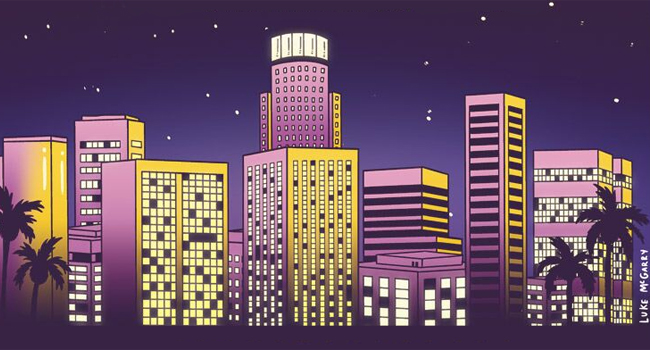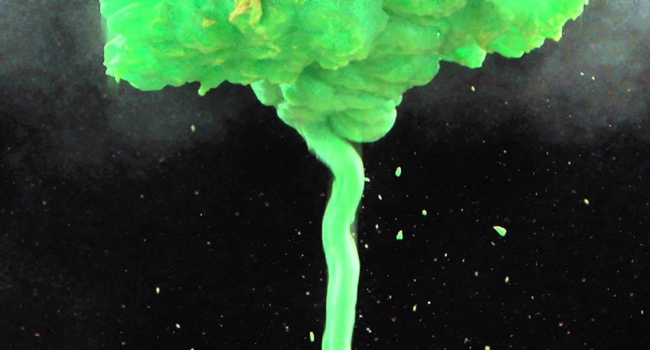50. The Knife – Silent Shout (2006):
 This Swedish duo’s dark, creepy elongated vocals serve as a perfect contrasting texture to the syncopated beats and minimalist rhythms in their third studio effort, Silent Shout. Following the success of single “Heartbeats,” The Knife traded in their seemingly bubbly melodies for a gothic blend of electronic and industrial dance tunes. Siblings Olof and Karin Dreijer’s love for distortion and synthesizers is evident in songs like “We Share Our Mother’s Health.” Devilish vocals and haunting intro leading into a synthpop riff break down is a theme seen throughout the album. The diversity of sounds The Knife creates is their signature and the reason this album is their stand out. –Kim Manning
This Swedish duo’s dark, creepy elongated vocals serve as a perfect contrasting texture to the syncopated beats and minimalist rhythms in their third studio effort, Silent Shout. Following the success of single “Heartbeats,” The Knife traded in their seemingly bubbly melodies for a gothic blend of electronic and industrial dance tunes. Siblings Olof and Karin Dreijer’s love for distortion and synthesizers is evident in songs like “We Share Our Mother’s Health.” Devilish vocals and haunting intro leading into a synthpop riff break down is a theme seen throughout the album. The diversity of sounds The Knife creates is their signature and the reason this album is their stand out. –Kim Manning
49. Amy Winehouse – Back to Black (2006):
 The music on Back to Black was the kind the world didn’t know it needed in 2006, and it was the beer chaser that made everything else in mainstream a little easier to swallow. Amy Winehouse, joined by The Dap-Kings, made a record that blended doo-wop and soul, with a pinch of funk to keep the mix fresh. Back to Black started with the infectious hit “Rehab,” but that was only a nugget of what the album offered. The music was ’60s sweet, but the lyrics and stories were present-day sour—sex, drugs, love and loss, as prevalent in such songs “Tears Dry on Their Own,” “You Know I’m No Good,” “He Can Only Hold Her” and the title track. –Ciara Shook
The music on Back to Black was the kind the world didn’t know it needed in 2006, and it was the beer chaser that made everything else in mainstream a little easier to swallow. Amy Winehouse, joined by The Dap-Kings, made a record that blended doo-wop and soul, with a pinch of funk to keep the mix fresh. Back to Black started with the infectious hit “Rehab,” but that was only a nugget of what the album offered. The music was ’60s sweet, but the lyrics and stories were present-day sour—sex, drugs, love and loss, as prevalent in such songs “Tears Dry on Their Own,” “You Know I’m No Good,” “He Can Only Hold Her” and the title track. –Ciara Shook
48. Converge – Jane Doe (2001):
 Consistently ahead of its time, Massachusetts’ hardcore act Converge was never afraid to challenge conventions. On its fourth studio album, vocalist/lyricist Jacob Bannon openly grappled with the dissolution of a relationship as guitarists Kurt Ballou and Aaron Dalbec created a cacophony that takes hold at “Concubine” and never lets go. Each second of Jane Doe seethes with fury, from the aptly titled “Bitter and Then Some,” to 11-minute titular track that slows the albums tempo without losing an ounce of energy. Jane Doe transcended its genre and gave credence to the often misunderstood band. Converge’s output post-Jane has been just as inspired, but this was the moment when Bannon’s vulnerability and the group’s self-assuredness was at its peak.-David Anthony
Consistently ahead of its time, Massachusetts’ hardcore act Converge was never afraid to challenge conventions. On its fourth studio album, vocalist/lyricist Jacob Bannon openly grappled with the dissolution of a relationship as guitarists Kurt Ballou and Aaron Dalbec created a cacophony that takes hold at “Concubine” and never lets go. Each second of Jane Doe seethes with fury, from the aptly titled “Bitter and Then Some,” to 11-minute titular track that slows the albums tempo without losing an ounce of energy. Jane Doe transcended its genre and gave credence to the often misunderstood band. Converge’s output post-Jane has been just as inspired, but this was the moment when Bannon’s vulnerability and the group’s self-assuredness was at its peak.-David Anthony
47. The National – Boxer (2007):
 As the world entered the mid-to-late-2000s and the indie music scene expanded beyond bands who were constantly being compared to Interpol, a vacuum was left over, waiting desperately for the best of alternative indie rock to fill it. The National’s Boxer was the answer to that vacuum. Mixing the fast-paced and, dare I say it, Interpol-esque guitar riffs of “Mistaken for Strangers” with the frenzied desperation of “Squalor Victoria” and the stark honesty of “Slow Show,” The National made a seamless, beautiful example of what indie rock should be without compromising the bare, almost guilt-ridden outlook on life that makes up a major theme of their work. –Leanne Howard
As the world entered the mid-to-late-2000s and the indie music scene expanded beyond bands who were constantly being compared to Interpol, a vacuum was left over, waiting desperately for the best of alternative indie rock to fill it. The National’s Boxer was the answer to that vacuum. Mixing the fast-paced and, dare I say it, Interpol-esque guitar riffs of “Mistaken for Strangers” with the frenzied desperation of “Squalor Victoria” and the stark honesty of “Slow Show,” The National made a seamless, beautiful example of what indie rock should be without compromising the bare, almost guilt-ridden outlook on life that makes up a major theme of their work. –Leanne Howard
46. The Hold Steady – Separation Sunday (2005):
 From the opening of “Hornets! Hornets!” to the very last note of “How a Resurrection Really Feels,” Craig Finn creates a universe where salvation is found through sex, drugs, and the seediest barroom rock ‘n’ roll. The album finds a way to make its story arch engrossing and constantly relatable, avoiding all of the concept album clichés. It’s since become the rallying cry for adults not yet ready to part with their youthful lifestyles. Aside from Finn’s spoken word delivery and hyper-dense lyricism, Separation Sunday is about as straightforward as a rock album can be without seeming trite. –David Anthony
From the opening of “Hornets! Hornets!” to the very last note of “How a Resurrection Really Feels,” Craig Finn creates a universe where salvation is found through sex, drugs, and the seediest barroom rock ‘n’ roll. The album finds a way to make its story arch engrossing and constantly relatable, avoiding all of the concept album clichés. It’s since become the rallying cry for adults not yet ready to part with their youthful lifestyles. Aside from Finn’s spoken word delivery and hyper-dense lyricism, Separation Sunday is about as straightforward as a rock album can be without seeming trite. –David Anthony
45. The Killers – Hot Fuss (2004):
 Is it cool to like Hot Fuss again? Certainly, few modern albums have stirred up as much debate. The naysayers write Hot Fuss off as a poor imitation of the “better” music that inspired it. Others mock Brandon Flowers’ faux British accent, or the Killers’ general disregard for all things that aren’t dripping in drama. It is this drama, however, that makes Hot Fuss the masterpiece it is. It turns out that a little bit of Las Vegas swagger and a whole lot of youthful exuberance were exactly the ingredients needed to bring synth-rock back into the international spotlight in 2004. Even at its most gaudy moments, the album doesn’t disappoint. The Killers put on a show, and they succeed in pulling the listener out of real life and into a world of murder mysteries, cheap girls, and neon lights—spawning countless imitations over the years to come. It is easy to find bands—from both the past and the present—that sound like The Killers. As a cohesive experience, however, Hot Fuss stands alone. –Derek Gossi
Is it cool to like Hot Fuss again? Certainly, few modern albums have stirred up as much debate. The naysayers write Hot Fuss off as a poor imitation of the “better” music that inspired it. Others mock Brandon Flowers’ faux British accent, or the Killers’ general disregard for all things that aren’t dripping in drama. It is this drama, however, that makes Hot Fuss the masterpiece it is. It turns out that a little bit of Las Vegas swagger and a whole lot of youthful exuberance were exactly the ingredients needed to bring synth-rock back into the international spotlight in 2004. Even at its most gaudy moments, the album doesn’t disappoint. The Killers put on a show, and they succeed in pulling the listener out of real life and into a world of murder mysteries, cheap girls, and neon lights—spawning countless imitations over the years to come. It is easy to find bands—from both the past and the present—that sound like The Killers. As a cohesive experience, however, Hot Fuss stands alone. –Derek Gossi
44. Spoon – Kill the Moonlight (2002):
 With Kill the Moonlight, Spoon ventured to create something decidedly different. Massive, corrosive, and vibrant, each track from the record rushes with emotion; summing up everything one would expect from an album by the Austin-based quartet, this time with extra production flourishes which only serve to accent all of their strengths. Largely upscale tracks such as “Jonathon Fisk” and “Someone Something” hit hard, beckoning with charismatic harmonies and powerful refrains that engulf the listener. And, of course, there’s the excellent single “The Way We Get By.” Kill the Moonlight marks a highpoint in the band’s consistent catalog, one that even their excellent 2007 release Ga Ga Ga Ga Ga couldn’t quite match. There is no other band quite like Spoon and Kill the Moonlight is their quintessential release. – Jon White
With Kill the Moonlight, Spoon ventured to create something decidedly different. Massive, corrosive, and vibrant, each track from the record rushes with emotion; summing up everything one would expect from an album by the Austin-based quartet, this time with extra production flourishes which only serve to accent all of their strengths. Largely upscale tracks such as “Jonathon Fisk” and “Someone Something” hit hard, beckoning with charismatic harmonies and powerful refrains that engulf the listener. And, of course, there’s the excellent single “The Way We Get By.” Kill the Moonlight marks a highpoint in the band’s consistent catalog, one that even their excellent 2007 release Ga Ga Ga Ga Ga couldn’t quite match. There is no other band quite like Spoon and Kill the Moonlight is their quintessential release. – Jon White
43. Ryan Adams – Heartbreaker (2000):
 Ryan Adams grew up in North Carolina and dug music the likes of The Replacements as a teenager—a subconscious bucking of his country surroundings, but returned to alt.country with Whiskeytown, a group he left shortly before embarking on a solo career. Heartbreaker is Ryan Adams’ handshake with country and his early punk influences, producing a spectrum including gentle tones (“Amy”), dusty lyrics from a seedy saloon (“Bartering Lines”), contemporary tracks (“Come Pick Me Up”) and rockabilly toe-tappers (“To Be Young,” “Shakedown on 9th Street”). Adams would go on to have an extensive career, albeit a notorious one because of his rumored addictions and neurotic behavior, and dimensional albums are the timecards of his experiences. –Ciara Shook
Ryan Adams grew up in North Carolina and dug music the likes of The Replacements as a teenager—a subconscious bucking of his country surroundings, but returned to alt.country with Whiskeytown, a group he left shortly before embarking on a solo career. Heartbreaker is Ryan Adams’ handshake with country and his early punk influences, producing a spectrum including gentle tones (“Amy”), dusty lyrics from a seedy saloon (“Bartering Lines”), contemporary tracks (“Come Pick Me Up”) and rockabilly toe-tappers (“To Be Young,” “Shakedown on 9th Street”). Adams would go on to have an extensive career, albeit a notorious one because of his rumored addictions and neurotic behavior, and dimensional albums are the timecards of his experiences. –Ciara Shook
42. Weezer – Pinkerton (1996):
 There’s a lot of pressure riding on a band that releases an instant classic like Weezer (The Blue Album) as their debut. Pinkerton follows through as the group’s sophomore effort—its predecessor’s matured counterpart. It doesn’t quite rise to The Blue Album’s hooky tunes and novelty hits, but it makes up with a dirtier sound matched with Weezer’s signature pop gleam. Where The Blue Album displayed the band’s innocence with fun songs “Buddy Holly” and “Surf Wax America,” Pinkerton displayed an older quartet with more feedback (“Getchoo”), more angst (“Tired of Sex”) and more songs about sexual conflict (“Pink Triangle”). Though this effort wasn’t fully embraced until years later, it now stands as a classic and perhaps the last great statement in the band’s catalog. –Ciara Shook
There’s a lot of pressure riding on a band that releases an instant classic like Weezer (The Blue Album) as their debut. Pinkerton follows through as the group’s sophomore effort—its predecessor’s matured counterpart. It doesn’t quite rise to The Blue Album’s hooky tunes and novelty hits, but it makes up with a dirtier sound matched with Weezer’s signature pop gleam. Where The Blue Album displayed the band’s innocence with fun songs “Buddy Holly” and “Surf Wax America,” Pinkerton displayed an older quartet with more feedback (“Getchoo”), more angst (“Tired of Sex”) and more songs about sexual conflict (“Pink Triangle”). Though this effort wasn’t fully embraced until years later, it now stands as a classic and perhaps the last great statement in the band’s catalog. –Ciara Shook
41. Sigur Rós – ( ) (2002):
 Much of the discussion of ( ) deals with its presentation: It lacks a proper album title, all of the songs are untitled, and the album booklet is filled with blank pages. Though this seems rather gimmicky, it is truly an important gesture. It shows that Sigur Rós understands the role of their music, particularly outside of Iceland. Listening to Sigur Rós is not about attempting to translate language, or even about discerning meaning of any kind. It is simply a medium through which listeners can let their own thoughts roam free. In this way, ( ) is more open and self-aware than Ágætis Byrjun, and yet it doesn’t come at the expense of its emotional impact. –Derek Gossi
Much of the discussion of ( ) deals with its presentation: It lacks a proper album title, all of the songs are untitled, and the album booklet is filled with blank pages. Though this seems rather gimmicky, it is truly an important gesture. It shows that Sigur Rós understands the role of their music, particularly outside of Iceland. Listening to Sigur Rós is not about attempting to translate language, or even about discerning meaning of any kind. It is simply a medium through which listeners can let their own thoughts roam free. In this way, ( ) is more open and self-aware than Ágætis Byrjun, and yet it doesn’t come at the expense of its emotional impact. –Derek Gossi



